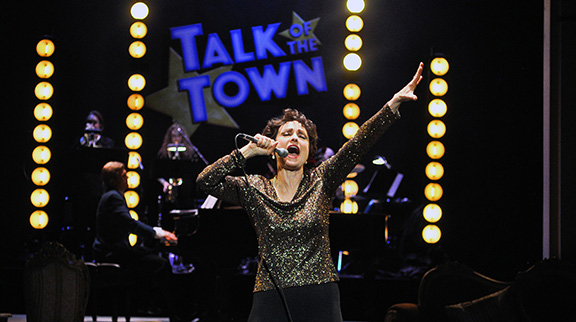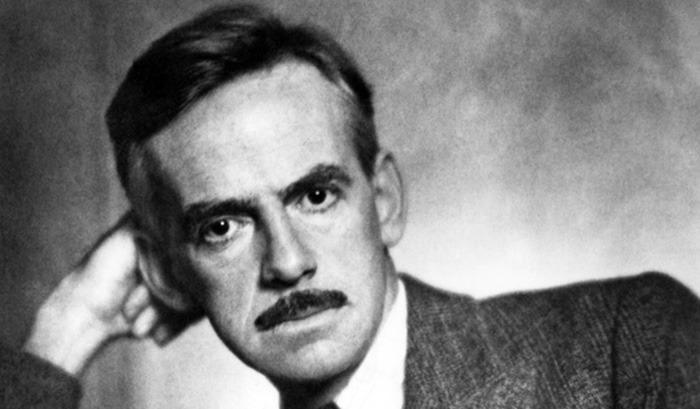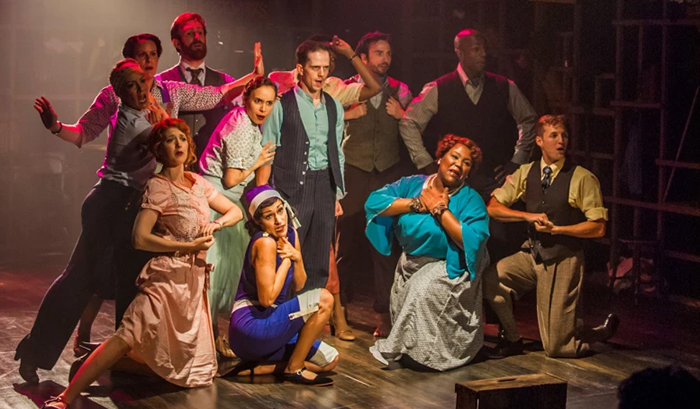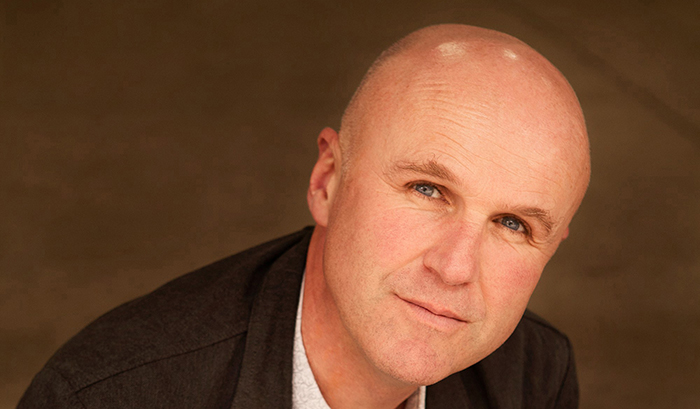
A Review of End of the Rainbow, on stage at the Long Beach International City Theatre.
Set during Judy Garland’s attempted comeback at London’s Talk of the Town nightclub in 1969, Peter Quilter’s End of the Rainbow is, in duck terms, an odd mallard. The narrative orbits addiction, but never is allowed to dip into the bleak emotions delivered so devastatingly in other addiction narratives like, to pick one example, Darren Aranofsky’s Requiem for a Dream. Yet the livening banter, sarcastic more than sparkly, never sheds enough bitterness to allow the story to lift up. Whatever amusement there is – and what amusement can there be in watching someone disintegrate? – is bitter-comic. There are beloved Garland songs, of course, some delivered with straight-up showmanship, others served on the rocks to depict her declining performance ability. Is it our toes that we’re supposed to tap, or our tear-ducts?
Let’s not kid ourselves into thinking that the play offers us any new insight into a signature performer from Hollywood’s Golden Age. The tale of celebrity self-destruction is a familiar one, with Garland only one in a parade of stars who have been tragically felled by drug and alcohol addiction. While the cast is small, we find embodied in the characters of Anthony (the pianist, portrayed by music director Brent Schindele), and Mickey Deans (the fiancé, portrayed by Michael Rubenstone) the expected muddle of supporters and enablers, exploiters and would-be saviours. Gigi Bermingham is given the role of Garland, which she ably inhabits with pathos if not fireworks. We have seen all this before. Only the names have been changed to satisfy tabloid prurience.
As one expects from the reliable ICT, it’s all well done, with agreeable performances situated in a clever set whose pieces move to reveal or conceal the band for musical numbers. Yet all the ICT’s skill can’t infuse ambition into a play that ultimately comes to rest in an old straw mattress: The dying star redeemed and immortalized via classic recordings and, arguably worse, nostalgia. A provocative question might be: What about audience complicity in a performer’s self-immolation on the altar of popular adoration? The better question must certainly be: Is great art, whatever its form, worth the artist’s suffering? We can’t fault Quilter for writing Garland a tear-streaked love letter instead of a postmodern autopsy. But shouldn’t we be savvy enough to move past the symptoms into a more substantive study of the narcotic crucible that forges a person into an icon?
The trouble with End of the Rainbow is that, aside from a tilt towards the pitying, it can’t balance the romance of Judy Garland with her “reality,” thereby reducing the impact of both. Of course, the act of dealing with iconic figures comes with its own set of rug-pullers: Garland’s high wattage works against serving an undistilled black comedy, while her addictive descent invariably dims the stage lights. The lukewarm result is that the pot of gold intended for the end of the rainbow is instead a pot of bronze.
End of the Rainbow. Written by Peter Quilter. Directed by John Henry Davis. Musical Direction by Brent Schindele. On stage at the International City Theatre in Long Beach. Performances from February 18 to March 15, 2015. For information and tickets, visit www.internationalcitytheatre.org or call 562.436.4610.








I can’t make heads or tails out of this writer’s various trains of thought. He’s like an undergraduate armed with a thesaurus who’s forgotten where his sentences have started by the time he gets to the ends of them.
I saw this play at ICT in Long Beach this past weekend, and thought it was splendidly done by a virtuoso cast. And the play certainly addresses head-on the issue of what it costs artists to make their art and please their audiences (this reviewer seems to think it didn’t, but it struck me right between the eyes in virtually every scene). And yes, “the tale of celebrity self-destruction is a familiar one”, but is this reviewer saying that therefore the playwright is wasting our time in exploring the dynamics of this particular case? The reviewer admits all the crucial ingredients are there – “supporters, enablers, exploiters, would-be saviors” – to show this problem honestly in all its true multifaceted complexity, and the playwright doesn’t whitewash or romanticize it. (The reviewer himself complains about the “bitterness” and “sarcasm” of the dialogue.)
I have no idea what “an old straw mattress” is, but the reviewer seems to think badly of it, saying that the play resolves with “the star redeemed and immortalized via classic recordings and…nostalgia”. I think history did that for Judy Garland, not the playwright, who barely nods to it at the very very end of the show. I also have no idea what the reviewer means when he says he’d prefer the play to be a “postmodern autopsy” (whatever that is) or a “more substantive study into the narcotic crucible” (the vast majority of the play involved Ms. Garland fighting her drug addiction). If his standard for dealing with substance abuse is the ridiculously harrowing, hallucinatory and bleak NC-17-rated 2000 film “Requiem for a Dream”, then he should stick to the 36-seat garage theaters along Pico Blvd. that “dare” to do that kind of work. Mainstream midsize theaters like ICT that are actually trying to pay their actors can’t afford to alienate the vast majority of their audience with that kind of niche work. And kudos to ICT for doing a play like “End of the Rainbow” that does make its audiences uncomfortable while still ultimately entertaining and uplifting them.
Postscript: speaking of “Requiem”, the reviewer misspelled its director’s name (Darren ArONOFsky). He also twice misspelled the name of “End of the Rainbow” actor and music director Brent SChindele.
Tom:
First, thank you for pointing out the typos. They do slip by us for various reasons, despite our best efforts to catch them. Even critics are human, although I admit the point is debatable.
Second, I’m glad you enjoyed the play. I much prefer people to enjoy themselves than not, even at productions I don’t personally care for.
Lastly, you may not care for my style of writing (and that’s fine – there’s no shortage of critics for you to choose from), but that’s not an excuse for being disingenuous.
I won’t fully unpack your critique of my critique, but I will address a few points.
You wonder whether I’m asking if the playwright is “wasting our time in exploring the dynamics of this particular case.” The answer is that I’m simply pointing out that the story is familiar: whether that’s a waste of time or not is for you to decide for yourself. (Considering that I wrote “As one expects from the reliable ICT, it’s all well done, with agreeable performances…” isn’t it a stretch for you to think I’m declaring the play a waste of time?)
Regardless of whether it is or not, End of the Rainbow certainly doesn’t offer any insight into drug addiction in general or Judy Garland in particular. And you bring up the enablers and so-on as examples of “multi-faceted complexity,” something I didn’t do. I mentioned them in the context that these are roles in a familiar story.
In the end, I clearly wrote that “The trouble with End of the Rainbow is that, aside from a tilt towards the pitying, it can’t balance the romance of Judy Garland with her ‘reality,’ thereby reducing the impact of both.” It is precisely because it tries to make audiences “uncomfortable” while also being “entertaining and uplifting” that it comes across as false. You claim that I complained “about the ‘bitterness’ and ‘sarcasm’ of the dialogue,” but you don’t seem to have actually read the sentence, which ended with “never sheds enough bitterness TO ALLOW THE STORY TO LIFT UP.” (Emphasis added.) The play is too bitter to be uplifting, and too entertaining to drive home the tragedy of drug addiction.
If you felt the balance was right, then I wouldn’t dream of telling you that you’re wrong. Opinion is just that – opinion. I stand by what I wrote, however, and thank you for taking the time to share your perspective.
Frederik – thanks very much for taking the time to respond and for clarifying your viewpoint. I think I understand your perspective better now.
Thanks for reiterating that you appreciated the good work that the production – the actors, director, designers, etc. – did to tell this story, and that your qualms were with the play itself. We can agree there.
And I think we can agree to disagree about your main point – the balance the play strikes, as you put it, between romance and reality. First, I think our disagreement about how much insight the play offers into the nature of drug addiction is one of degree. I felt the play didn’t treat Judy Garland’s condition in a facile or one-dimensional way at all. But then I also didn’t think the play was primarily ABOUT addiction; it was an important factor or theme in the story, but the play wasn’t purporting to use Judy Garland merely as a convenient vehicle to explore the clinical intricacies of substance abuse.
Second and more importantly, I now understand your opinion that the show ultimately is “neither here nor there” because, as you put it, it’s “too bitter to be uplifting, and too entertaining to drive home the tragedy”. I think that’s a valid argument, though I disagree in this case. It may be a matter of personal taste, but I find the best stories (plays, films, books, etc.) are precisely the ones that manage to steer between mindless distraction and unremitting bleakness. Which led to my more pragmatic point – that midsize theaters in L.A. at their best seek that middle road, to challenge their audiences without alienating them or wearing them down into utter desolation. A spoonful of sugar helps…
Thanks again for your time.
Comments are closed.